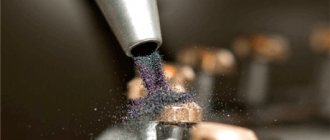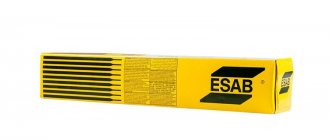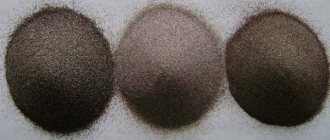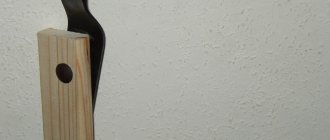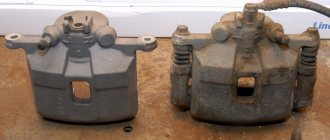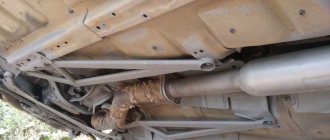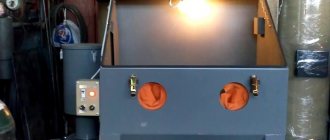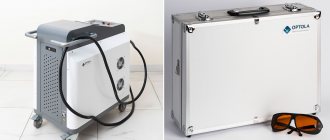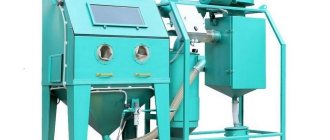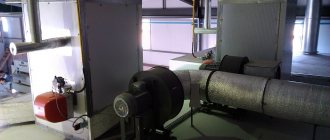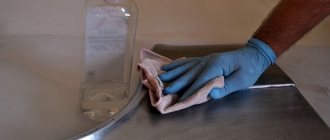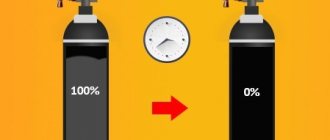When choosing a suitable abrasive material for sandblasting metals, it would be correct to take into account not only the price component of the material itself, but also focus on such an indicator as:
- rate of consumption of sand and material when processing metal.
Sand consumption for metal sandblasting is the most important indicator. It is identified and installed at the preparatory stage, before carrying out cleanup work, since the calculation allows us to establish the necessary financial costs for the entire available treatment area. In this case, such components of the process as the assembly of previously used material, the strength, hardness and thickness of the layer of contaminants on the metal, the characteristics of the material from which it is made, the plane and its condition, and the time required to carry out the work are taken into account.
The best abrasive material for cleaning metal will be the one that will help to obtain the highest rates of treated areas at the minimum cost of the work performed.
There are a number of criteria that are most positive for abrasive sand used in abrasive blast cleaning of metals. If you adhere to them, then its consumption during sandblasting will be optimal. Moreover, these criteria are in a direct cause-and-effect relationship with the place and purpose of the upcoming processing.
The maximum economic effect can be expected if sand of a suitable fraction is used for sandblasting metal in surface cleaning systems and in specialized prepared abrasive cleaning boxes. The involvement of sand and quartz-containing materials in abrasive blasting cleaning activities makes it possible to achieve a minimum cost of the work carried out. Analysis of such a component of the process as the consumption of sand during sandblasting of metal per 1 m2 of the area being cleaned can only be carried out approximately since
since its consumption depends on a large number of factors, except for the material itself from which it is made. Next, there is a gradation comparison of the consumption of abrasive materials for cleaning devices, which are used relatively often. Consumption calculation is indicated in kg.
per 1 m2 of metal, to obtain a degree equal to Sa 21⁄2, ISO 8501-1. Quartz sand: per 1 m2 when cleaning the metal to a degree of Sa 2½60-110 kg/m²Cooper slag: per 1 m² when cleaning to a degree Sa 2½35-80 kg/ m² Nickel slag: per 1 m² when cleaning to Sa 2½ 35-80 kg/m² Electrocorundum (corundum): per 1 m² to cleaning degree Sa 2½ kg/m² The sand consumption rate for sandblasting metal is 2-3 liters. sand per minute of work. From which it follows that the actual consumption of sand when carrying out work in the third position is 2 liters.
per minute: 144 kg. per hour or 96 l. per hour. Optimizing the cost of materials for a sandblaster is a very real task, provided that during the work, durable abrasive substances suitable for repeated use are used. Effective regeneration is undoubtedly achieved by modern units such as abrasive blasting systems with a closed processing cycle, vacuum systems for collecting waste material and wearable systems that prevent the spread of material.
However, it is also important to choose the appropriate fraction for specific types of work. So, to clean the surface from several old layers of paint, advanced levels of rusting of metal or residues of a cement-containing substance, enlarged grains of sand are used, which form a deep profile. Sand grains of the middle fraction combat surface rusting, poorly fixed, weak paint or a thin layer of soot. Small fractions are optimal for sandblasting thin metal products, since they form a surface profile. With large sandblasting of metal, sand consumption per square centimeter of the metal surface of the treated area, fewer grains of sand are consumed and therefore not all places will be sandblasted.
Using reusable materials, it is necessary to constantly supplement the working mixture to guarantee high-quality processing and maximum productivity. Fresh sand forms a uniform relief on the surface, however, after each subsequent regeneration, the grains of sand become smaller and smaller. It is in order to avoid this effect that the operator needs to periodically monitor the quality of the material being processed and, if necessary, add sand. With this method, the size of the fraction of the resulting mixture will be averaged between the size of the new and already used material. A non-standard approach to the work process when using abrasive will result in benefits expressed in decent cleaning quality.
But still, the final effect will depend on the particular characteristics of the specific material used. Date: 04/08/2015 Comments: Rating: 32 The number of materials used in the world for abrasive blasting is large. It is not practical to mention all of them. Let's focus on the ones most in demand by our compatriots. Garnet abrasive sand is used mainly in the operation of machines and waterjet cutting equipment.
How can you calculate sand consumption when sandblasting metal?
Sand consumption for metal sandblasting is the most important indicator. It is identified and installed at the preparatory stage, before carrying out cleanup work, since the calculation allows us to establish the necessary financial costs for the entire available treatment area. In this case, such components of the process as the assembly of previously used material, the strength, hardness and thickness of the layer of contaminants on the metal, the characteristics of the material from which it is made, the plane and its condition, and the time required to carry out the work are taken into account.
The best abrasive material for cleaning metal will be the one that will help to obtain the highest rates of treated areas at the minimum cost of the work performed. There are a number of criteria that are most positive for abrasive sand used in abrasive blast cleaning of metals. If you adhere to them, then its consumption during sandblasting will be optimal. Moreover, these criteria are in a direct cause-and-effect relationship with the place and purpose of the upcoming processing.
The maximum economic effect can be expected if sand of a suitable fraction is used for sandblasting metal in surface cleaning systems and in specialized prepared abrasive cleaning boxes. The involvement of sand and quartz-containing materials in abrasive blasting cleaning activities makes it possible to achieve a minimum cost of the work carried out.
Analysis of such a component of the process as sand consumption during sandblasting of metal per 1 m2 of cleaned area can only be carried out approximately because since its consumption depends on a large number of factors, except for the material itself from which it is made.
Calculation example for metal processing 1m2
Next, there is a gradation comparison of the consumption of abrasive materials for cleaning devices, which are used relatively often. Consumption calculation is indicated in kg. per 1m2 of metal, to obtain a degree equal to Sa 21⁄2, ISO 8501-1.
Characteristics
The main properties that determine the quality of a material such as abrasive powder are:
- Degree of hygroscopicity. The smaller it is, the better the product. Dry powders can be used immediately in the production process, without wasting time and money on drying.
- Flowability. This indicator for abrasive powders should be as high as possible. Very loose materials easily pass through the nozzle of tools designed for cleaning surfaces without clogging them. As a result, the equipment does not fail longer.
- Fraction ratio. Only material that contains particles of different sizes (from 0.5 to 3 mm) is considered high-quality.
According to the degree of danger to the human body, abrasive powder is classified in the fourth group. This means that you can work with it without fear of harming your health. For comparison: the same fourth hazard class includes materials such as scrap metal and powder remaining when grinding metal parts.
Which sand is best for a sandblaster?
The following types of sand are used for sandblasting:
- Quartz, obtained by crushing quartz-containing rocks. This is the most popular type of sand with acute-angled particles, which increase the productivity of the device and reduce the consumption of abrasive during sandblasting.
- Quartz industrial, specially designed for sandblasting.
- Construction river or quarry. Used in cases that do not require high hardness of the abrasive substance. Before use, it must be washed to remove impurities that reduce the effectiveness of the treatment. To clean a structure or an old building from old paint, you can use quarry or river sand, not divided into fractions.
- Pomegranate. This material is superior in hardness to quartz. Due to its high cost, it is used only in certain cases, mainly for hydraulic cutting of metals.
Technologies and methods of surface treatment
The method is based on spraying powdered soda (sodium bicarbonate) with compressed air using a blasting machine. Surface cleaning occurs due to a micro-explosion that occurs when sodium bicarbonate particles and contaminants come into contact at high speed. The energy released during this contact clears any foreign substances from the plane of the structure. In this case, the material of the product itself is not destroyed or damaged.
This technology is called soda blasting, Nord Blast equipment allows you to use not only soda, but also high-hardness abrasive materials, such as marble, which allows you to use several surface treatment methods: abrasive cleaning, sandblasting, and the use of water and a water separator in Nord Blast devices make it possible to prevent dust from entering the atmosphere; this technology is called water-jet surface treatment. Water jet cleaning is used in food industry enterprises where dust formation is not allowed.
The unique properties of this technology have ensured the popularity and wide range of use of blasting processing devices.
Processing of various surfaces of materials
- brickwork
- concrete walls
- bottoms of ships and watercraft
- car bodies
- steel structures
- pools and fountains
- monuments
How to choose the right consumables
It is clear that sandblasting different types of surfaces requires different consumables. The right choice allows you not only to increase the efficiency and speed of the processing performed, but also to significantly save on its implementation. The following factors influence which consumable material to choose for a sandblasting machine.
- The thickness of the layer of coating or contamination that needs to be removed, as well as its strength. If you choose a fine abrasive with low hardness for a thick and durable layer of coating or contamination to be removed, you may simply not achieve the desired result.
- The hardness of the material being cleaned. For harder substrates, you should choose a harder abrasive, and for soft ones, a less hard one, so as not to damage the surface being treated.
- Requirements for the surface condition after treatment. If the cleaned surface should have a minimum number of dents and chips, then for its processing you should choose an abrasive of a finer fraction.
- Required sandblasting speed. A hard abrasive, the particles of which have sharp edges, provides a higher processing speed than a similar one with rounded particles.
- Possibility of organizing the collection and reuse of abrasive. If this is not possible, then it is more advisable to use more inexpensive materials for processing: quartz sand, cooper slag and nickel slag.
Comparison of the main parameters of abrasive materials will help you make the right choice
Abrasive Differences
Abrasive processing allows you to clean metal structures and concrete slabs using microparticles that are blown out by a powerful air stream. The equipment creates kinetic energy, which throws the abrasive onto the surface being treated at tremendous speed. In this way, frozen deposits are removed from the material.
Sand for sandblasting varies in material and particle size. In order to obtain a high-quality surface after processing, a number of requirements should be taken into account:
- To be considered high quality, sand for sandblasting goes through several stages of processing before being put on sale. It is not profitable to buy expensive mixtures, but cheap ones will damage the material when the compressor operates.
- Sand for sandblasting is selected depending on the type of material being processed. Construction stores sell universal mixtures.
- If the surface of the part is damaged, gentle abrasives must be selected. They will maintain the integrity of the workpiece.
- Fraction. Fine abrasive is not economical for cleaning areas with a large layer of plaque. At the same time, it is suitable for finishing work.
Often purchased mixtures are diluted with various chemical additives. You need to pay attention to this when choosing.
Corundum (aluminum dioxide and oxide, electrocorundum)
Markings and designations on abrasive wheels.
This type of abrasives is an industrially produced crystalline aluminum oxide (dioxide). This is a material with high abrasive efficiency. Its hardness is only one unit less than that of diamond. The ability to use it repeatedly makes the material indispensable in a dust-free cleaning system, in a sandblasting chamber, in offices and cabins. Lighter, compared to metal shot, corundum particles more often than others find their use in sandblasting injection chambers.
Aluminum oxide as an abrasive is involved in decorative processes, for example, in steel (and other types of materials) matting. Sandblasting using corundum is one of the shortest in terms of time.
How to dry sand for sandblasting
Modern industry produces various installations for drying bulk substances. These include a drum sand dryer. A drying chamber with a built-in sieve allows you to significantly reduce the drying time and combine it with sifting sand, which will ultimately improve its quality.
At home, drying sand for sandblasting is possible using one of the following methods. Secure a sheet of metal or metal box to the legs. Light a fire under it, or install a heater or other heater. Pour raw river sand onto a metal surface to dry. You can also dry sand scattered on film or other material using a heat gun.
Prices for quartz pellets in bags, per ton
The average price for quartz sand in Moscow varies, depending on the fraction and packaging. Sales are carried out in bags of 25 and 50 kg, small size.
| Sand in bags of 25 kg | MKR (from 1 ton) | MKR (from 20 tons) | |
| Light rounded quartz sand (SiO2 no less than 99%) | 135 – 300 rubles depending on volume and fraction | 3,700 – 4,900 rubles depending on faction | 3,500 – 4,700 rubles depending on faction |
| Dark rounded quartz sand | 345 – 300 rubles depending on volume | from 3900 rubles | 3,700 rubles |
| White quartz chips | 250 – 460 rubles depending on volume and fraction | 8,400 – 14,000 depending on faction | 8,300 – 13,000 depending on faction |
If you want to purchase sand for abrasive work in Moscow, St. Petersburg, Yekaterinburg or other cities of Russia, our company offers modern abrasive for sandblasting work. High-quality and safe abrasive powder of various fractions with a purity degree of up to Sa3.
produces granulated slags for sandblasting for effective and safe cleaning of various types of surfaces in accordance with international requirements and safety standards. A wide network of our own warehouses and representative offices allows our customers to buy abrasive sand at competitive prices and with a quality guarantee. Highly qualified company managers will select the required type of abrasive and its fractional composition, based on the problems that you need to solve.
Cooperation with UralGrit means high efficiency and safety of your work, economical use of budget and time, comfortable service and optimal solution to even the most complex problems.
Description
Cooper slag is a type of abrasive powder used for blast cleaning of surfaces and structures. From English Copper Slag. It is a by-product of extracting copper from ore by smelting. Other names: cup slag, granulated slag, granulated slag, copper slag.
Designed to remove deep rust, old thick coatings, mill scale and other contaminants from metal and concrete.
Achievable degrees of metal purification: Sa 2, Sa 2½ and Sa 3 (1-3 according to GOST 9.402-2004).
Resulting surface profile (roughness): from 40 to 140 microns (suitable for all types of anti-corrosion protection).
There is the possibility of recovery (reuse) up to three times.
Supplied fractions (mm): 0.2 – 1.6 | 0.5 – 1.5 | 0.5 – 2.5 | 0.5 – 3.0 | 0.8 – 3.0
Dynamic strength coefficient – 17.4
Abrasiveness coefficient – 4.2
Mohs hardness – 5.5 ÷ 6.0
Bulk density, kg/m3 – 1400
Packaging – MKR (Big Bag), 1 ton.
Cooper slag consumption varies widely and depends on many factors, such as: type, diameter and condition of the nozzle, position of the metering valve, compressor performance, air pressure, fraction and quality, type and degree of surface contamination, required degree of cleaning, operator qualifications - and ranges from 80 to 1000 kg/hour (this does not take into account the time of refueling the device and other downtime). In practice, one 200-liter barrel of abrasive “goes away” in an average of 40 minutes.
The average slag consumption for cleaning one square meter of surface (with optimally selected components of the abrasive blasting complex) is 30 ÷ 90 kg/m 2. If the components are selected incorrectly, there will be excessive consumption of powder, and the cleaning speed will be lower.
Pickup - from a warehouse in Krasnodar, top loading.
We also supply cooper slag throughout Russia by railcars.
The product is popular and sells out quickly, so please check current availability by phone.
275 rub. up to 10 mesh
- up to 10 mesh 4300 rub.
- 11-20 mesh 4250 rub.
- 21-40 mesh 4200 rub.
- from 41 mesh. 4150 rub.
4300 rub. up to 10 mesh
- up to 10 mesh 4100 rub.
- 11-20 mesh 4050 rub.
- 21-40 mesh 4000 rub.
- from 41 mesh. 3950 rub.
4100 rub. up to 10 mesh
Abrasive powder is obtained from nickel and copper smelting waste by breaking up and crushing granulated slag. Abrasive powder is also known by other names: cooper slag, nickel slag and granulated slag. Cooper slag is a waste from the copper industry, nickel slag is a waste from the nickel industry, and granular slag is obtained from granules (hence the name of the powder).
Read also: Which sander is better for sanding putty on walls?
